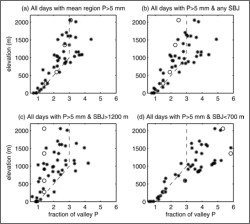HMT Publication Notice
As part of HMT's Quantitative Precipitation Forecasting (QPF) and Hydrologic Applications Major Activity Areas, this paper evaluates how well orographic precipitation gradient (OPG) can be predicted and represented by 3 different methods: (1) a linear model of orographic precipitation, (2) monthly Parameter-Elevation Regressions on Independent Slopes Model (PRISM) precipitation data, and (3) seven years of hourly wind profiler data used to identify characteristics of the Sierra barrier jet (SBJ). Through examination of the average precipitation distribution for the northern Sierra Nevada for the period 2001 to 2007, during which key HMT wind-profiler and additional observational datasets were available, this paper investigates patterns of precipitation and characteristics of the atmospheric flow that impinge on the mountains and act to modify precipitation patterns.
The results showed that although all three methods represented the OPG well in the mean and during years when less than 30% of the precipitation occurred on days with SBJs, the linear model and PRISM did not adequately capture annual variations in the OPG during years when more than 70% of the precipitation occurred on days with SBJs. This indicates that SBJ activity may a primary cause of precipitation patterns deviating from those patterns estimated by an idealized model or PRISM. In addition, analysis of the wind profiler data indicated that variations in the height of the SBJ (i.e., wind flowing parallel to the terrain) are negatively correlated with the OPG (see Figure 8). Hence, lower SBJ heights tend to occur with larger OPG gradients, which in turn tend to occur when the westerly winds are stronger. Thus, westerly storms tend to result in greater increases of precipitation with elevation, which act to increase snow storage in most storms and to increase storm runoff during warmer-than-average storms. These results have been presented at the CNRFC, Sacramento WFO and the California Department of Water Resources.


 Read the Abstract
Read the Abstract